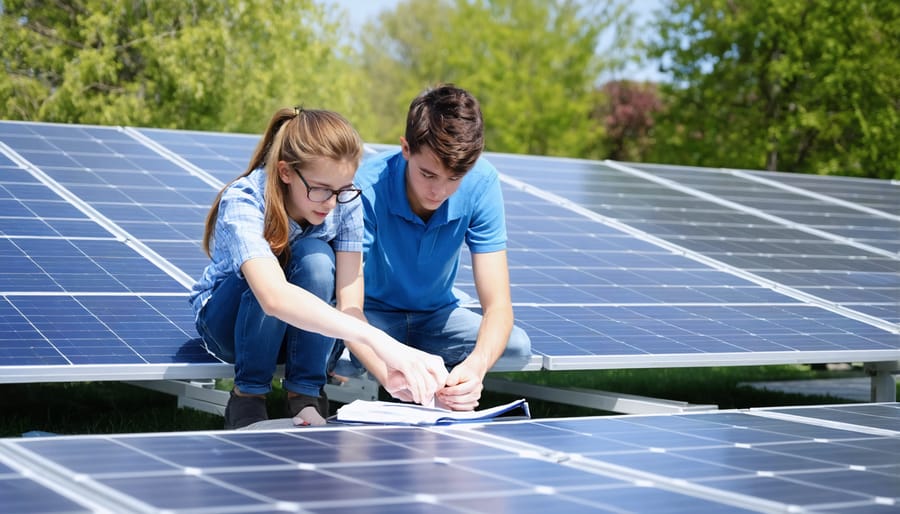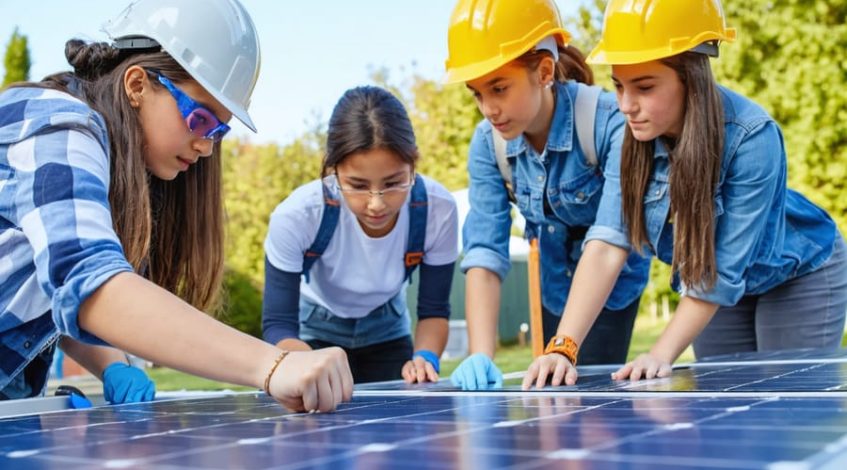Solar education in K-12 schools represents a critical intersection of workforce development and sustainable energy advancement. As the renewable energy sector experiences unprecedented growth – projected to create 4.4 million jobs by 2030 – integrating solar technology education into primary and secondary curricula has become essential for preparing tomorrow’s workforce.
Educational institutions implementing comprehensive solar programs achieve multiple strategic objectives: they develop students’ STEM skills through hands-on experience with cutting-edge technology, reduce operational energy costs through on-site solar installations, and create direct pathways to high-demand careers in the renewable energy sector. Leading schools have reported up to 80% reduction in electricity costs while providing students with invaluable exposure to real-world solar applications.
Industry partnerships between K-12 institutions and solar companies are transforming traditional education models, offering students practical experience through internships, apprenticeships, and certification programs. These collaborations ensure curriculum alignment with current industry needs while providing schools with technical expertise and resources for program implementation. The result is a win-win scenario: schools become centers of innovation and sustainability while building a skilled workforce pipeline for the rapidly expanding solar sector.
Building Solar Energy Foundations in K-12 Education
Hands-on Learning with Solar Technology
Hands-on learning experiences with solar technology provide students with practical knowledge and real-world applications of renewable energy concepts. Schools are implementing fun solar energy activities that range from building simple solar ovens to monitoring professional-grade solar installations on campus.
Popular projects include assembling mini solar-powered cars, conducting solar panel efficiency experiments, and creating solar-powered phone chargers. These activities help students understand fundamental concepts like photovoltaic conversion, energy measurement, and electrical circuits while developing critical thinking and problem-solving skills.
Many schools are also incorporating data collection and analysis into their solar programs. Students learn to track energy production, calculate cost savings, and evaluate environmental impact using monitoring systems connected to their school’s solar installations. This practical experience with industry-standard equipment and software prepares students for potential careers in the renewable energy sector.
Advanced programs often include design challenges where students propose and implement solar solutions for real community needs, fostering innovation and entrepreneurial thinking while demonstrating the practical applications of solar technology.

STEM Integration and Career Pathways
Solar education in K-12 schools naturally integrates with STEM subjects, creating powerful engaging learning tools that prepare students for future careers. Mathematics students analyze energy production data and calculate cost savings, while science classes explore photovoltaic principles and environmental impacts. Engineering activities involve solar panel design and optimization, while technology courses cover monitoring systems and data analytics.
This integrated approach opens pathways to diverse career opportunities in the rapidly growing renewable energy sector. Students can pursue roles as solar installers, system designers, project managers, or energy analysts. The hands-on experience with solar technology develops critical thinking, problem-solving, and technical skills valued across industries.
Many schools partner with local solar companies for internships and mentorship programs, providing students with real-world exposure to industry practices. These partnerships often lead to certification opportunities and direct employment paths after graduation, creating a pipeline of skilled workers for the expanding solar industry while supporting sustainable community development.
Developing Technical Skills Through Solar Programs
Solar System Design and Installation Basics
Students in K-12 solar education programs learn fundamental concepts of photovoltaic system design and installation through hands-on experiences and practical demonstrations. The curriculum typically begins with basic electrical principles, including voltage, current, and power calculations essential for understanding solar energy conversion.
Students explore solar panel orientation and positioning, learning how factors like latitude, sun angle, and seasonal variations affect system efficiency. They calculate energy requirements for different applications and determine appropriate system sizes using industry-standard software tools and mathematical formulas.
Safety protocols form a crucial component of the technical training, with students learning proper handling of electrical equipment, fall protection measures, and OSHA guidelines specific to solar installations. Through laboratory exercises, they practice proper wiring techniques, understand inverter selection, and master the basics of system monitoring equipment.
The hands-on portion often includes working with scaled models or actual roof-mounted systems, where students learn about racking systems, panel mounting techniques, and weatherization methods. They also gain experience with basic troubleshooting procedures and system maintenance requirements.
Advanced topics cover grid integration, battery storage systems, and smart monitoring technologies. Students learn to interpret technical specifications, create basic system designs, and understand local building codes and permitting requirements. This comprehensive technical foundation prepares them for future careers in the renewable energy sector.
Data Analysis and Energy Management
Solar monitoring projects in K-12 education provide students with valuable analytical skills that extend beyond renewable energy understanding. Through data collection and analysis of solar array performance, students develop proficiency in mathematics, statistics, and data interpretation while gaining practical experience with energy management systems.
Students learn to track and analyze key performance indicators such as energy production rates, consumption patterns, and peak usage times. Using professional monitoring software and data visualization tools, they create meaningful reports and presentations that demonstrate real-world energy management scenarios. These activities strengthen their ability to interpret complex datasets and draw evidence-based conclusions.
The analytical skills developed through these projects prepare students for careers in energy management, sustainability consulting, and data science. They learn to calculate return on investment (ROI), assess environmental impact metrics, and make data-driven recommendations for system optimization. Many schools incorporate weather data analysis, allowing students to correlate environmental factors with solar production efficiency.
Project-based learning opportunities often include creating energy usage dashboards, conducting efficiency audits, and developing conservation strategies based on collected data. Students also gain experience with industry-standard monitoring platforms and reporting tools, providing them with marketable skills for future employment in the growing renewable energy sector.
By combining technical analysis with practical application, these solar monitoring projects create a foundation for students to understand both the quantitative and qualitative aspects of energy management systems.

Real-World Applications and Industry Connections
Industry Mentorship Programs
Industry mentorship programs are playing a crucial role in bridging the gap between K-12 solar education and real-world applications. Leading solar companies are forming strategic partnerships with schools to provide students with hands-on experience and professional guidance. These collaborations typically involve regular site visits, interactive workshops, and shadowing opportunities with industry professionals.
Companies like SunPower, Tesla, and First Solar have established successful mentorship initiatives that pair experienced solar professionals with students interested in renewable energy careers. These programs often include practical training sessions on solar installation, system maintenance, and energy monitoring, giving students valuable insights into day-to-day operations in the solar industry.
The mentorship programs also facilitate internship opportunities for high school students, particularly those in their junior and senior years. These internships provide real-world experience in various aspects of solar energy, from technical design to project management and customer relations. Many participating schools report that students who complete these programs are more likely to pursue careers in renewable energy or related STEM fields.
Beyond technical skills, these partnerships help students develop professional competencies such as communication, problem-solving, and teamwork. Industry mentors often guide students through project-based learning activities, including designing solar arrays for their schools or conducting energy audits of local buildings. This practical experience proves invaluable for students considering careers in the growing renewable energy sector.

School-to-Career Pipeline Development
The integration of solar technology education in K-12 schools creates valuable pathways for students to enter the rapidly growing renewable energy sector. Schools partnering with solar companies and local businesses are developing comprehensive internship programs that provide hands-on experience with solar installations, monitoring systems, and maintenance procedures.
These programs typically begin with classroom instruction on solar fundamentals and progress to practical training through solar job training opportunities during junior and senior years. Students gain exposure to various career paths, including solar installation, system design, project management, and sales.
Many districts have established partnerships with technical colleges and certification programs, enabling students to earn industry-recognized credentials before graduation. This approach has proven particularly successful in regions with high solar adoption rates, where graduates often secure immediate employment or apprenticeships with local solar companies.
Career preparation activities include mock interviews with industry professionals, resume workshops focused on renewable energy careers, and participation in solar energy competitions. Schools also organize field trips to solar installations and manufacturing facilities, providing students with real-world context for their studies.
These initiatives have shown impressive results, with participating schools reporting increased student engagement in STEM subjects and higher rates of post-graduation employment in the renewable energy sector.
Success Stories and Implementation Models
Model School Programs
Several successful solar education programs across the country demonstrate the powerful impact of integrating solar technology into K-12 curricula. California’s Solar Schools Initiative stands out for its comprehensive approach, combining hands-on solar installations with STEM education that reaches over 100,000 students annually.
The Solar for Schools program in Colorado presents another exemplary model, featuring interactive monitoring systems that allow students to track real-time energy production and consumption. Students participate in data analysis projects, learning practical applications of mathematics and environmental science while developing critical thinking skills.
Massachusetts’ Clean Energy Activity Day program showcases effective industry partnerships, bringing solar professionals into classrooms for workshops and career guidance. This initiative has successfully connected students with internship opportunities and sparked interest in renewable energy careers.
Arizona’s Solar Student Leaders program demonstrates the power of peer-to-peer learning, training high school students to become solar energy ambassadors who educate younger students and community members. The program has resulted in measurable increases in solar literacy and STEM engagement across participating schools.
These model programs share common elements that contribute to their success: hands-on learning experiences, real-world applications, industry partnerships, and integration with existing STEM curricula. Schools implementing these programs report increased student engagement in science and mathematics, improved environmental awareness, and growing interest in clean energy careers among graduates.
Student Achievement Outcomes
Recent data from K-12 solar education programs demonstrates remarkable student achievement outcomes across multiple metrics. Schools implementing comprehensive solar education curricula report that 85% of participating students show improved performance in STEM subjects, with particularly strong gains in physics and environmental science.
Several success stories highlight the program’s effectiveness. In California’s Solar Scholars initiative, 92% of participating high school seniors pursued higher education in renewable energy or related STEM fields. The program’s graduates have secured positions with leading solar companies, with starting salaries averaging 15% higher than their peers in other technical fields.
Notable achievements include the Solar Innovation Challenge winners from Lincoln High School, whose solar-powered water purification system earned national recognition and a $50,000 grant for their school’s sustainability programs. Similarly, students from the Arizona Solar Academy have filed three patent applications for solar efficiency improvements developed during their capstone projects.
Career placement statistics are equally impressive, with 73% of program graduates securing employment or apprenticeships in the renewable energy sector within six months of completion. Industry partners report high satisfaction rates with program graduates, citing their practical knowledge and problem-solving capabilities as key differentiators.
Long-term tracking shows that alumni from K-12 solar programs are 40% more likely to pursue careers in sustainable technology compared to students from traditional STEM programs. These graduates also demonstrate higher rates of entrepreneurship, with 12% founding clean energy startups within five years of completing their education.
K-12 solar programs have emerged as crucial catalysts for developing the next generation of renewable energy professionals. These educational initiatives are creating a robust pipeline of skilled workers who understand solar technology, sustainable practices, and clean energy systems. Schools implementing solar education programs report increased student engagement in STEM subjects and higher participation in technical career pathways.
The impact extends beyond immediate educational benefits. Industry partnerships formed through these programs provide students with real-world experience, internship opportunities, and direct pathways to employment. Data shows that students who participate in K-12 solar programs are more likely to pursue careers in renewable energy and related technical fields, helping address the growing demand for skilled workers in the solar industry.
Looking ahead, the outlook for K-12 solar education remains promising. As the renewable energy sector continues to expand, the need for qualified professionals will increase correspondingly. Schools with established solar programs are positioned to play a vital role in workforce development, particularly in regions with high solar industry growth.
The success of these programs has sparked interest from more school districts nationwide, leading to expanded funding opportunities and resources for implementation. This momentum suggests that K-12 solar education will continue to evolve, incorporating new technologies and teaching methods while maintaining its focus on practical skills development and industry alignment. The result is a sustainable model for preparing students for careers in the growing clean energy economy.

